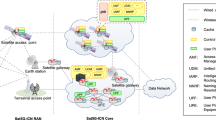Abstract
The emerging 4G (fourth generation) networks featuring wider coverage, higher transmission bandwidth and easier deployment have a desirable potential to serve ubiquitous and pervasive multimedia applications in creating new user-centric communication services. However, the practical implementation of 4G network to demonstrate such potential, especially for delivering real-time and high-quality video services, is scarce. This paper therefore provides the design and implementation of a future Internet live TV system over 4G networks to achieve cost-effectiveness, instead of using expensive satellite news gathering (SNG) vehicle and costly satellite transmissions in traditional TV stations. To effectively provide live TV services, we apply not only the hybrid duplex modes but also the port-based VLAN on the deployed networks for maximizing bandwidth, minimizing signal interference, and guaranteeing QoS of differentiated services. Performance metrics are applied to demonstrate that the proposed solution is cost-effective and is feasible for live TV services in future Internet.

















Similar content being viewed by others
References
IEEE 802.16-2001 (2002). IEEE standard for local and metropolitan area networks. Part 16. Air interface for fixed broadband wireless access systems.
Ma, L., & Jia, D. (2005). The competition and cooperation of WiMAX, WLAN and 3G. In Proceedings of the 2nd international conference on mobile technology, applications and systems (pp. 1–5).
Chang, R., & Lee, C. (2009). IP video surveillance applications over WiMAX wireless broadband technology. In Proceedings of fifth international joint conference on the INC, IMS and IDC (NCM’09) (pp. 2100–2102).
Wireshark: network protocol analyzer. http://www.wireshark.org/.
She, J., Hou, F., Ho, P., & Xie, L. (2007). IPTV over WiMAX: key success factors, challenges, and solutions. IEEE Communications Magazine, 45(8), 87–93.
Zhang, Y., Ansari, N., & Tsunoda, H. (2010). Wireless telemedicine services over integrated IEEE 802.11/WLAN and IEEE 802.16/WiMAX networks. IEEE Wireless Communications, 17(1), 30–36.
VideoLan VLC decoder and player. http://www.videolan.org/.
Liu, H., Wang, C., Chang, R., & Hsieh, C. (2009). A cost-effective Wimax deployment for high-quality video streaming of live news reporting. In IEEE mobile WiMAX symposium 2009, Napa Valley, California, USA, 9–10 July.
WiMAX forum® and ITRI announce the first Taiwan WiMAX operators summit. http://www.wimaxforum.org/node/544.
2007 WiMAX forum Taipei showcase & conference. http://wimaxshowcase.tca.org.tw/2007/about_m_taiwan.php.
European Telecommunications Standards Institute (ETSI) (2004). Standard EN 302 304 Ver. 1.1.1. Digital video broadcasting (DVB), Transmission system for handheld terminals (DVB-H)
Kornfeld, M., & May, G. (2007). DVB-h and IP datacast—broadcast to handheld devices. IEEE Transactions on Broadcasting, 53(1), 161–170.
Yun, S., Park, S. Y., Lee, Y., Park, D., Kim, Y., Kim, K., & Kang, C. G. (2007). Hybrid division duplex system for next-generation cellular services. IEEE Transactions on Vehicular Technology, 56(5), Part 2, 3040–3059.
Chan, P. W. C., Lo, E. S., Wang, R. R., Au, E. K. S., Lau, V. K. N., Cheng, R. S., Mow, W. H., Murch, R. D., & Letaief, K. B. (2006). The evolution path of 4G networks: FDD or TDD? IEEE Communications Magazine, 44(12), 42–50.
Rajaravivarma, V. (1992). Virtual local area network technology and applications. In Proceedings of the twenty-ninth southeastern symposium on system theory (Vol. 9, pp. 49–52).
IEEE standards for local and metropolitan area networks (2001). Virtual bridged local area networks—amendment. 2. VLAN classification by protocol and port.
Sportack, M. (1999). IP routing fundamentals. Cisco Press: Indianapolis.
Semaan, G. (2008). Designing networks with the optimal availability. In Proceedings of optical fiber communication/national fiber optic engineers conference (Vol. 24, pp. 1–6).
MSU video quality measurement (VQT) tool: PSNR calculation. http://www.compression.ru/video/index.htm.
Stewart, R., & Metz, C. (2001). SCTP: new transmission protocol for TCP/IP. IEEE Journal of Internet Computing, 5(6), 64–69.
Stewart, R., et al. (2000). Stream control transmission protocol. IETF, RFC 2960.
Stewart, R., et al. (2007). Stream control transmission protocol. IETF, RFC 4960.
Alinejad, A., Philip, N., & Istepanian, R. S. H. (2010). Performance analysis of medical video streaming over mobile WiMAX. In Proceeding of 2010 annual international conference of the IEEE engineering in medicine and biology society (EMBC) (pp. 3471–3474).
Carneiro, G., & Ricardo, M. (2007). QoS abstraction layer in 4G access networks. Telecommunications Systems, 35(1), 55–65.
Lian, S., & Chen, X. (2010). Lightweight secure multimedia distribution based on homomorphic operations. In Telecommunication systems. Published online: 24 June 2010.
Acknowledgements
This paper was partially supported by NSC Taiwan under grants NSC98-2410-H-002-060-MY2 and NSC98-2218-E-002-042.
Author information
Authors and Affiliations
Corresponding author
Rights and permissions
About this article
Cite this article
Liu, HS., Wang, CH. & Chang, RI. The design and implementation of a future Internet live TV system over 4G networks. Telecommun Syst 54, 203–214 (2013). https://doi.org/10.1007/s11235-013-9728-8
Published:
Issue Date:
DOI: https://doi.org/10.1007/s11235-013-9728-8




